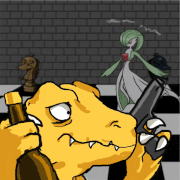|
There are videos of preachers giving sermons, PISSED that modern translations replace “him who pisseth against the wall” with “men”. e: lol the infamous guy has his own YouTube account and has repeated the sermon ad nauseam since https://www.youtube.com/watch?v=GqLZKhJ1Zkk
|
|
|
|

|
| # ? May 15, 2024 01:41 |
|
This is less ancient history and more archaeology related but we are swiftly reaching the time where modern aluminium cans and the like are going to be classified as artifacts and require 106 compliance and people are losing their god drat minds. Its kinda great, especially because people already hate historic can dumps and the like.
|
|
|
|
Telsa Cola posted:There apparently some native plants floating around that area that have the same spiciness level though you get weird side effects with them like numbing. Ill have to look back at what they were called but I know at least one of them is illegal to import to the states. Well I don't know what India has, but Sichuan Pepper has the numbing property you describe, and is (surprisingly enough) from the Sichuan region of China. I wouldn't describe it as spiciness with a side-effect of numbing though. It isn't really spicy at all, in the sense of "hot". The numbing is all it has, no capsaicin. If you've never had it you owe it to yourself to try some; it's by far my favorite spice. Any decent chinese restaurant will use it in their Mapo Tofu. It was banned for import into the US until 2005 so it's not as common in American Chinese as it otherwise might have been but these days you can find it on the spice rack of any high end supermarket.
|
|
|
|
Telsa Cola posted:
just imagine someone getting really loving confused about 'corn' being a new world product, but it's mentioned in the bible which is way older than colombus, and you know those mormons think the native americans were secretly jewish and HOW DEEP DOES THE CONSPIRACY GO
|
|
|
|
cheetah7071 posted:Well I don't know what India has, but Sichuan Pepper has the numbing property you describe, and is (surprisingly enough) from the Sichuan region of China. I wouldn't describe it as spiciness with a side-effect of numbing though. It isn't really spicy at all, in the sense of "hot". The numbing is all it has, no capsaicin. If you've never had it you owe it to yourself to try some; it's by far my favorite spice. Any decent chinese restaurant will use it in their Mapo Tofu. It was banned for import into the US until 2005 so it's not as common in American Chinese as it otherwise might have been but these days you can find it on the spice rack of any high end supermarket. Specifically recommend the green variety: https://www.amazon.com/Soeos-Authen...=gateway&sr=8-3 More pungent and flavorful than the other common variety. E: It was once common in Korean food as well, so much so that in Central Asia they call it Korean pepper. You still find old ladies selling it in street markets now and then. It's a close relative of the sansho that's used in Japan. Grand Fromage fucked around with this message at 08:12 on Aug 20, 2019 |
|
|
|
Telsa Cola posted:There apparently some native plants floating around that area that have the same spiciness level though you get weird side effects with them like numbing. Ill have to look back at what they were called but I know at least one of them is illegal to import to the states. Sichuan pepper is and was used in Chinese and Indian cuisine before the introduction of the chili. Also, that CSPAM ancient history thread is pure distilled 
|
|
|
|
cheetah7071 posted:Well I don't know what India has, but Sichuan Pepper has the numbing property you describe, and is (surprisingly enough) from the Sichuan region of China. I wouldn't describe it as spiciness with a side-effect of numbing though. It isn't really spicy at all, in the sense of "hot". The numbing is all it has, no capsaicin. If you've never had it you owe it to yourself to try some; it's by far my favorite spice. Any decent chinese restaurant will use it in their Mapo Tofu. It was banned for import into the US until 2005 so it's not as common in American Chinese as it otherwise might have been but these days you can find it on the spice rack of any high end supermarket. Thanks! Thats definitely one of the things I was thinking of though I clearly got the location wrong. I had an anthropology of food course way back in my undergrad and one of the professors proctoring it had specfic interest in chilis so we got quite a few articles on them and similar spices. Telsa Cola fucked around with this message at 08:14 on Aug 20, 2019 |
|
|
|
Don Gato posted:From personal experience, the Yasukuni Shrine is very much its own category of crazy nationalist compared to the others I've seen in Japan (when I went there was a placard claiming WWII was caused by the US forcing Japan to conduct Pearl Harbor and all Japan wanted to do was create a greater east asian co-prosperity sphere against imperialism), but I'll readily admit I haven't been to Korea or China yet so I don't know what those museums are like. Japanese academic history is quite left-leaning and has been for quite a while. The Yasukuni Museum on the other hand, is not curated by Japanese academics, but the private religious corporation that runs Yasukuni Shrine, which is not a publically funded entity. ofc, a powerful political faction in the LDP are avid supporters of this private entity and its allies, but they don't get funding from the national budget, so its the same pickle as all those American megachurches that sell MLM faith-healing schemes and just happen to have good friends in congress/senate. HEY GUNS posted:meanwhile, if they had existed in europe all along, why would a minor 16th century french noble mention in his diary the day he walked down to the beach and saw shipping crates full of them, lying on the sand, as a ship was being unloaded? A guy can try for an artsy thing for just one diary entry without getting judged like this, please.
|
|
|
|
KiteAuraan posted:I've wondered about Indian food, with my best guess being lower spice with maybe an increased amount of black and long pepper and ginger than modern recipes. If it was as pungent as the post-chili cuisine at all. Coriander, cumin, turmeric, ginger, garlic, asafoetida, mustard seeds, fennel, fenugreek etc. etc. are all native to the Old World. Tomatoes are what distinguish pre-exchange South Asian food from modern, chili is barely relevant
|
|
|
|
Squalid posted:I was surprised to see baleen was apparently a standard component of European composite crossbows. Still not sure if the could be used in the same way as horn (I think it's made of keratin too). The author who I read describing it wasn't sure either. I assume it's somewhere in this cross section but not sure where These strips of baleen can be quite large, it would be interesting to try it. In "Die Hornbogenarmbrust", the author cites various medieval regulations that stipulate which materials are legal to use, and how they should be offered as. E.g. it's forbidden to advertize or repackage crossbows made of cow horn as the ones made of ibex. Ibex being recognized as the most superior material available in the alps, and the venetians went a long way to secure a supply of it. It's also quite thick per default, whereas cowhorn isn't and also it's layers can come apart. Modern bowyers don't use cow horn at all because of this. Some species might be an exception, but with cattle being slaughtered as soon as they reach a certain weight, you don't get old animals with thick horns anymore. Most ottoman bow that we have here are actually made with a greyish horn from oxen, which comes from an area around Izmir.
|
|
|
|
Power Khan posted:Ibex being recognized as the most superior material available in the alps, and the venetians went a long way to secure a supply of it.
|
|
|
|
Power Khan posted:Thanks! I'm dating a Mongolian and she half translated the Mongolian text before she got the shits and told me to gently caress off. Also the last half of it is russian which she only had a passing knowledge of "I had a chance to feel the ancient bow and arrows from 13th century from my hometown, between Hagt and Tekht in Altantsugts, Bayan-Ulgii Mongolia. Thick strings and thick nock seem to shows that mongolian knights used some serious Uriankhain drawing style when they shoot. All these artefacts have been discovered by Mongolian Science Academy Archeologists, Amartuvshin, Erdene-Ochir and Galsan. The main thing that i would like to specify from what i saw, within the arrows found in corroded quiver, was one with wooden arrowhead seems to be from Uriankhai. When i tried to pull it out to take a closer look, it has been stuck with the other. Looked like the arrowhead has been sculpted from the main body, and the nock seemed non existent which looked like the strings have been tied with tendon, which appears to be 5 mm thick. But in my opinion there is no point connecting the strings with tendons."
|
|
|
|
Big Willy Style posted:I'm dating a Mongolian and she half translated the Mongolian text before she got the shits and told me to gently caress off. Also the last half of it is russian which she only had a passing knowledge of Noice. Thx.
|
|
|
|
Is it normal to have a gut hatred for everyone posting in that c-spam thread
|
|
|
|
Edgar Allen Ho posted:Is it normal to have a gut hatred for everyone posting in that c-spam thread Look, I’m just spreading forbidden knowledge about the Tartarian Empire. Wake up sheeple
|
|
|
|
Edgar Allen Ho posted:Is it normal to have a gut hatred for everyone posting in that c-spam thread Surely the cure for misinformation is knowledgeable posters going over there rather than letting them wallow in a quarantine of ignorance?
|
|
|
|
Long pepper is way more like chile pepper than black pepper is. Much spicier, a touch of fruity flavor, generally delicious. You can see how it would fill the same niche as chiles. I highly recommend getting some on amazon to try, very tasty stuff.
|
|
|
|
Platystemon posted:There are videos of preachers giving sermons, PISSED that modern translations replace “him who pisseth against the wall” with “men”. lol this is gold. I will not let a woman tell me how to live my life (within said woman's home). Yet something tells me he has strong as hell feelings about what women should do with their lives.
|
|
|
|
Delthalaz posted:Look, I’m just spreading forbidden knowledge about the Tartarian Empire. Wake up sheeple What's their relationship with the Bolivian/Atlantean of old?
|
|
|
|
Yadoppsi posted:Surely the cure for misinformation is knowledgeable posters going over there rather than letting them wallow in a quarantine of ignorance? Nice troll.
|
|
|
|
Wheres that map of the Korean empire
|
|
|
|
Dalael posted:What's their relationship with the Bolivian/Atlantean of old? That's a great question. Fortunately the researchers over at Stolen History dot org have delved deeply into the topic. https://www.stolenhistory.org/search/54662/?q=atlantis
|
|
|
|
Edgar Allen Ho posted:Is it normal to have a gut hatred for everyone posting in that c-spam thread I will admit my Chaco Regional System hypothesis is fringe, but I try to support it with archaeological data. Excavations at Mitchell Springs, Steve Lekson's Chaco work, recent work by a plethora of researchers on Pueblo Bonito, Neil Judd's published excavation records, settlement patterns post-CE 1240, known examples of warfare and the forms it takes in the period (Steve LeBlanc's Prehistoric Warfare in the American Southwest is a good overview), recent work at Aztec and Salmon (which prior to old data may not have been sacked, but rather a closing ritual involving disentering bodies, placing them in the tower kiva and burning it may have happened, it looks quite different from Mitchell Springs in form). There is a Great House with similar evidence for sacking and cannibalism in the Puerco Valley, at the other end of the former Chaco sphere, so something was going on. The big thing is more excavation at late Great Houses, which, luckily, is currently ongoing. Crow Canyon Archaeology Center is doing some work at another late one in the Montezuma Valley that will provide some more data. On the history side, there are some Pueblo histories that do recount Chaco elite, who fell and were seen as immoral because they gained too much power over people, and there are the Gambler stories of the Diné, about a figure who ruled Chaco and kept slaves that may derive from Pueblo oral histories. Also, I ramble too much about it, since it's one of my research areas.
|
|
|
|
Delthalaz posted:That's a great question. Fortunately the researchers over at Stolen History dot org have delved deeply into the topic. I have spent years reading conspiracies and fake history because it's so fun and I never saw this website before. Thanks I'm gonna have so much fun with this.
|
|
|
|
The Tucson loving Artifacts. Supposed Roman-Jewish crosses and lead objects with inscriptions telling of a lost expedition from Constantinople to the Tucson Basin around CE 700-900 where they fought the natives and founded a kingdom in exile. Even Dean Byron Cummings of the University of Arizona thought they were real. Except, we know a lot about the archaeology of that period. It is the Tucson Basin Hohokam sequence, the Colonial Period, Cañada del Oro-Rillito Phases. At this time population is growing, local ceramic traditions are diverging from the earlier pan-Hohokam traditions and ample trade is going south to the Trincheras Culture and north to the Phoenix Basin Hohokam. In none of these areas are there signs of any warfare, invasions of metal-using people or new diseases like smallpox. Everything is pretty stable and peaceful. Which of course leads to the artifacts themselves. They were found in soil that had been quick set into caliche with lime. The inscriptions were passages from Latin textbooks used at the time (1924) and student of Latin scrawlings with very poor grammar. This led Hohokam expert Emil Haury and Chaco expert Neil Judd to declare, at the time, that they were clearly fake. This did not close the case. In the 1970s, some quack named Cyclone Covey, without any excavation, wrote an entire book about a massive Jewish settlement that was the origin of the artifacts, with no evidence. And recently the History Channel has declared them real, after absolutely awful "chemical sourcing". So are they real? Yeah, no. They are currently at the Arizona Historical Society museum in Tucson, where they are kept as curiosities of an era of hoaxes. Sometimes they are on display and researchers with the right credentials can view them. The Cardiff Giant of the Desert, a set of Sagauro Country Keningston Runestones. Bane of Hohokam specialist and Classical researcher alike, cornered by people who get all their information from the History Channel.
|
|
|
|
Edgar Allen Ho posted:Is it normal to have a gut hatred for everyone posting in that c-spam thread People read cspam?
|
|
|
|
Yadoppsi posted:Surely the cure for misinformation is knowledgeable posters going over there rather than letting them wallow in a quarantine of ignorance?
|
|
|
|
KiteAuraan posted:Also, I ramble too much about it, since it's one of my research areas.
|
|
|
Edgar Allen Ho posted:Is it normal to have a gut hatred for everyone posting in that c-spam thread you guys do understand that that thread is talking about stuff on the tier of the hwan empire, bolivian atlantis, and the phantom time hypothesis in exactly the same way this thread has many times throughout its history, right? no one is actually buying into it. it exists to be all bolivia all the time, because it's funny. there seem to be a few credulous morons posting in that thread also, but this kind of cspamphobia is just silly. we're literally the same people you've been posting with for years, cspam's population didn't materialize from nowhere. so in short, no, it's not normal Jazerus fucked around with this message at 00:15 on Aug 21, 2019 |
|
|
|
|
Jazerus posted:you guys do understand that that thread is talking about stuff on the tier of the hwan empire, bolivian atlantis, and the phantom time hypothesis in exactly the same way this thread has many times throughout its history, right? no one is actually buying into it. it exists to be all bolivia all the time, because it's funny. there seem to be a few credulous morons posting in that thread also, but this kind of cspamphobia is just silly. we're literally the same people you've been posting with for years, cspam's population didn't materialize from nowhere. no, the people posting about bows for 3 pages are superior damnit
|
|
|
|
Dalael posted:I have spent years reading conspiracies and fake history because it's so fun and I never saw this website before. Thanks I'm gonna have so much fun with this. You’re welcome! Yeah, I love that stuff too and I think I only found the website recently. I actually figured I heard about it in this thread but maybe not. What I find so fascinating about the Tartaria conspiracy is it’s such a weirdly specific misreading of sources that, like, it feels as if it has to be someone’s intentional fantasy world building exercise or maybe some sort of ARG or something. Maybe some people’s minds just aren’t meant to be exposed to the ocean of information out there on the internet and their connection-finding neurons misfire in intriguing ways.
|
|
|
|
I hate that I know about the cspan history thread. I feel like some knowledge leaked out of my brain due to reading some of it
|
|
|
|
Senior Dog posted:no, the people posting about bows for 3 pages are superior damnit power khan is recreating an ancient art form himself by hand in his spare time, what are you doing with your life
|
|
|
|
KiteAuraan posted:Also, I ramble too much about it, since it's one of my research areas. you should keep posting about it itt. and other archaeology news you fancy if you want to get anal about history this is the place to do it, rather than C-spam
|
|
|
|
HEY GUNS posted:power khan is recreating an ancient art form himself by hand in his spare time, what are you doing with your life I don’t know who that is and have no wish to denigrate them, but are you saying they’re superior because they make bows as a hobby?
|
|
|
|
Yes. He owns.
|
|
|
|
All right let's cut this direction off before it starts going nasty.
|
|
|
|
So I am going to do a bit of a big posg about the Chaco Regional System, cannibalism, war, revolt and the end of the Mesa Verde sequence. The Chaco Regional System begins, fitting enough, at Chaco Canyon. That is the park where Pueblo Bonito is in central New Mexico. Quite quickly a system defined by regional exchange of goods into the canyon, but not out, pilgrimage, and a spread of local Great Houses spreads, from the Puerco Valley on the west, east to around Acoma, north into the Mesa Verde region and canyon country of east Utah and south to around modern Zuni. For our purposes, I will focus on the Mesa Verde region, as that seems to be where the system moves after the core stops being Chaco Canyon around CE 1150, and to a lesser extent on Pueblo Bonito. The principle time periods are Pueblo II and Pueblo III, consisting of the Bonito and McElmo Phases of Chaco Canyon proper. This is a period from about CE 950-1280, though mostly CE 1050-1240. One intersting thing about the Chaco Regional System is there seems to be a decent amount of cannibalism going on. Steve LeBlanc gives an overview in "Prehistoric Warfare in the US Southwest" and it is striking how many Great Houses in the CE 1000-1240 period show evidence for cannibalism. Yucca House is an interesting one, as it is less than a day away from Mitchell Springs and has a kiva with as many as 90 individuals that seem to have been cannibalized. What differs from Mitchell Springs is they don't seem to be locals. They have cranial deformation consistent with another Pueblo region. So were they brought their by Great House elites and killed and eaten to send a message? Were they sacrifices, like is possible for 12 individuals at Pueblo Bonito? Are they elites killed and placed in a kiva by locals who then bury their dead formally at the site? There does seem to be a rash of attacks on both Great Houses and small sites across the region, almost as if the residents of each are locked in some sort of struggle. If it was a conflict, it seems to evolve out of people growing tired of being sacrificial victims and grain-producing nodes at a time of drought, since the earlier cannibalism seems to be by elite at their Great Houses. What I noticed going over LeBlanc's dataset is that the Great Houses don't tend to have the same reported damage as Mitchell Springs, suggsting the cannibalism is a rite or ritual and not an attack in the earlier Bonito Phase examples. By the McElmo Phase something changes and elite get attacked. Aztec Ruin and Salmon Ruin throw a bit of a wrench in this model. They seem to be founded by people from Chaco Canyon, abandoned briefly and then inhabited by people from the Mesa Verde area. What is less clear is if they kept their elite identity, like the people at Mitchell Springs, or if it was like Lowry Pueblo and the remodeling corresponded with a sort of "democratization" of a formally elite space, turning it from palace to typical pueblo. Both have violent ends involving burning and unburied bodies. Burning alone could just be a closing ritual, like that observed for the later Homolovi II, but the unburied and burnt bodies are evidence of an attack. But is it attack on elites or commoners? One version of this model, that I ascribe to, is that toward the end of the Chaco Regional System, you begin to see an increase in burnt small sites and cannibalism events at Great Houses, almost as if the elite are sending a message. Then this switches as people band together, as seen in the sack of Mitchell Springs. Also, some recent reevaluation of Aztec and Salmon (William Lipe mentions this in "In Search of Chaco") suggest they actually are occupied continually, just at low levels, which would be consistent and that both continue to be important local centers of power. If this is the case, their ends around CE 1280 (for Aztec) and 1266 (for Salmon) match the observation at Mitchell Springs. In sum, that in Late Pueblo III, after almost 200 years of abuse, small house farmers launch a series of attacks on Great Houses that, unlike Lowry, do not adapt to new, less hierarchical forms of organization. An increase in large aggregated sites in the Mesa Verde region (the setting for this drama) seems to result from small house farmers moving together for safety in the aftermath of the CE 1240 fall of Mitchell Springs, and this conflict or fear of it, spreads south, as similar patterns occur shortly after in the El Morro Valley and Puerco Valley. Now, of course another model also exists. That this is endemic warfare brought on by resource stress. However earlier episodes of drought, and a drought in the region around CE 1150 don't have similar total breakdowns. Part of that is it seems whatever monopoly on violence the Great House people have at that time, which involved cannibalism, keeps people fearful enough to not act. Or even the ritual systems have not yet collapsed, keeping some order in the late CE 1100s. The populist revolt model has some support from are the Pueblo histories of powerful rulers at this time, and the nature of Great Houses, with their low living room counts relative to storage rooms (Mitchell Springs Pueblo A has about 30 rooms, 3 of which are living rooms) and high levels of exotic goods compared to small houses which suggest special people. There is bioarchaeological evidence that the earlier denizens of Pueblo Bonito in Chaco Canyon itself came from a single matrilineage and maintained that identity for centuries, suggestive of an elite family. The denizens of Mitchell Springs also seem to have plenty of time to build power, as they live in an area that had been a center of gatherings since at least Pueblo I, and unlike many people in the Montezuma Valley (a subset of the Mesa Verde region) they stay throughout early Pueblo II, never leaving for the Dolores Canyon to the north or Chaco Canyon to the south. It suggests great ties to the area that enabled the 5 Mitchell Springs Great Houses to be built. Meaning elites existed and could have been long lived and despotic enough to inspire revolt. The big question about the final end of the Chaco Regional System and the Mesa Verde occupation in the 1200s then is not really, were there elites and violence, but what elites and violence mean. The archaeological data is there, but we're still building models and testing them to find the best fit. Was there populist revolt? Was it endemic warfare rising in the absence of the powerful Chaco Canyon center as the smaller scale Aztec, Salmon, Lowry etc. Great Houses fail to keep order? Both? Neither? And this isn't even touching on the cliff dwellings, which begin around CE 1200 and like the large mesa and valley sites represent numerous small households coming together in villages and are VERY defensive. I have one model I favor, but the issue is still how few Great Houses have been excavated. We really need more data for anything to be conclusive. I'll post some pictures I've taken of some of these places once I have access to a PC that can upload them, though that may take some time.
|
|
|
|
I am both amazed at how much we can discover from just archaeology and annoyed we dont know more. I can't think of any long run cannibalistic cultures, although I am sure others have examples.
|
|
|
|
|

|
| # ? May 15, 2024 01:41 |
|
It seems to be more like the Aztecs (not to be confused with Aztec Ruins, which has nothing to do with them and predates them by a couple centuries) where cannibalism was a ritual and religious practice that also had political goals of inspiring fear in others. Subsistence cannibalism to the best of my knowledge is really rare because it's a bad way to run a society. And it may be one reason why the Hohokam of the Phoenix Basin gradually move trade ties away from the Northern San Juan as Chaco moves in there, and re-align with Kayenta, Tusayan and Little Colorado peoples not engaged with the Chaco system. Or Chaco cuts them off, since they offerred an alternative to elites, with no real evidence for power over people sort of rule and a more egalitarian system that may have had local office holders who helped manage the irrigation system. Thing is, these people tend to be identified based on burial goods, and if the goods do represent badges of office, it seems that most households or neighborhoods had one person a generation in an office, so it seems more egalitarian. I have poured over A LOT of reports and burial forms and most Hohokam sites really have nothing resembling an "elite" district comparable to Chaco Great Houses. Which given the scale of their canal systems flies in the face of conventional ideas about irrigation societies. My hypothesis on that is nested responsibility for canal duties, where it goes household (field plot) to neighborhood (distribution canal) to neighborhood cluster (branch canal) to village (main canal segment). Each level would have office holders explaining the wide distribution of "rich" burials with badges of office. These probably also had some religious and other social duties but taboos against accumulating power. Which sort of makes sense, you don't want bad blood between people on the same canal, all sharing a common water source in the Sonoran Desert, so why be despotic if cooperation works? Sort of the opposite of Chaco.
|
|
|




























 Yes, it's like a lava lamp.
Yes, it's like a lava lamp.













